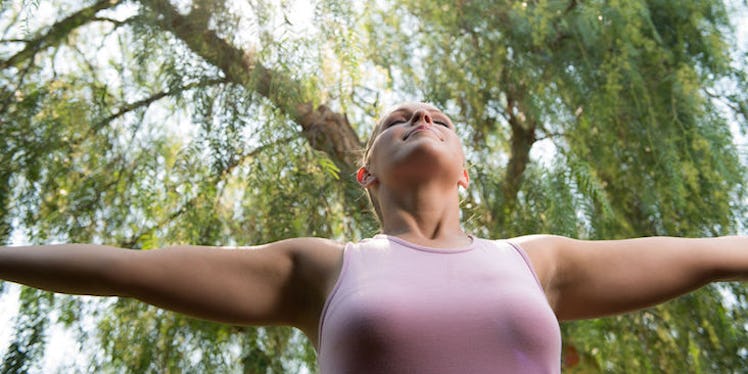
Here's Why You Should Let Go & Make All The "Weird" Noises You Want During Yoga Class
Picture this: You're in a yoga class, expecting things to be quiet and placid throughout, but eventually everyone around you starts moaning, groaning, and loudly expressing sighs of relief and surrenders. Quite frankly, some people might be really turned off by the thought of expressive, vocal release in yoga, but as a teacher who's had a variety of different studio experiences, my absolute favorite type of class is one where all the yogis are encouraged to deeply inhale, and on the exhale, to let out great, big HAAAAAAs of breath. Making "weird" noises during yoga certainly isn't for everyone, but according to experts, getting vocal on your mat can serve as an incredible form of relief. So if it's something if you haven't tried yourself yet, maybe it's time to reconsider.
"Yoga is a somatic experience," Wendy DeRosa, a personal/spiritual growth teacher, author, and founder of the School of Intuitive Studies, tells Elite Daily over email. Of course, yoga is a personal practice, one that can look very different from person to person, but according to DeRosa, the practice is generally meant to help unblock "stuck" energy inside the body. For some, she says, this translates to a verbal expression of release through "a variety of bodily noises."
So what is it about making sounds like groans, moans, lip trills, all of that "weird" stuff, that deepens the practice so much and changes the whole experience?
Personally, as a woman who often feels silenced and censored in her everyday life, being loud and unrestricted on my yoga mat feels thoroughly freeing; that's what keeps me coming back again and again. And the fact that I feel this way makes sense, says Melissa Okabe, a yoga instructor based in Los Angeles. "Making 'weird' noises is related to self expression, and self expression is associated with the fifth chakra (or throat chakra)," she tells Elite Daily over email. "Vocalizing your emotions via chanting, expressive breath, [or] speaking your truth, all stimulate this important energy center."
Physically, Okabe says, making these types of noises can also encourage deeper diaphragm breathing. "[The noises] all start with a full, large breath in, and the noises are made on the exhalations. This is important because as the focus draws to the exhale, it encourages release — release of anxiety, toxins, emotional baggage, stress, etc.," the yoga teacher explains.
Even if you're not getting vocal throughout your entire flow, some specific breathing techniques taught in yoga class are a bit "noisier" than others. Techniques like lion's breath, breath of fire, and bee breath, for instance, all encourage you to really engage your diaphragmatic breath in a vocal way, according to Okabe.
I won't lie to you: Breathing this way might be nerve-wracking at first. Whether you're breathing loudly during a round of breath of fire or letting out a juicy moan on your exhale as you drape over your knees in forward fold, it might be difficult to center in on being vocally expressive without caring what other people think.
If that's your concern, Okabe offers a simple reminder about what your yoga practice is really all about: "Yoga, at the end of the day, is a personal practice; it’s a journey inward, and each person’s practice and experience will be as unique as they are," she explains.
Additionally, DeRosa stresses the notion that release is an important part of taking care of yourself. "Allowing your body to release through sound and breath is moving energy and clearing your system," she tells Elite Daily.
Ultimately, "the yoga room is a place of acceptance, non-judgment, [and] self exploration," Okabe tells Elite Daily. So the next time you're in class and taking a deep breath in, simply go for it and get loud on that exhale, girl. Who knows — you may even inspire your neighbor to do the same.